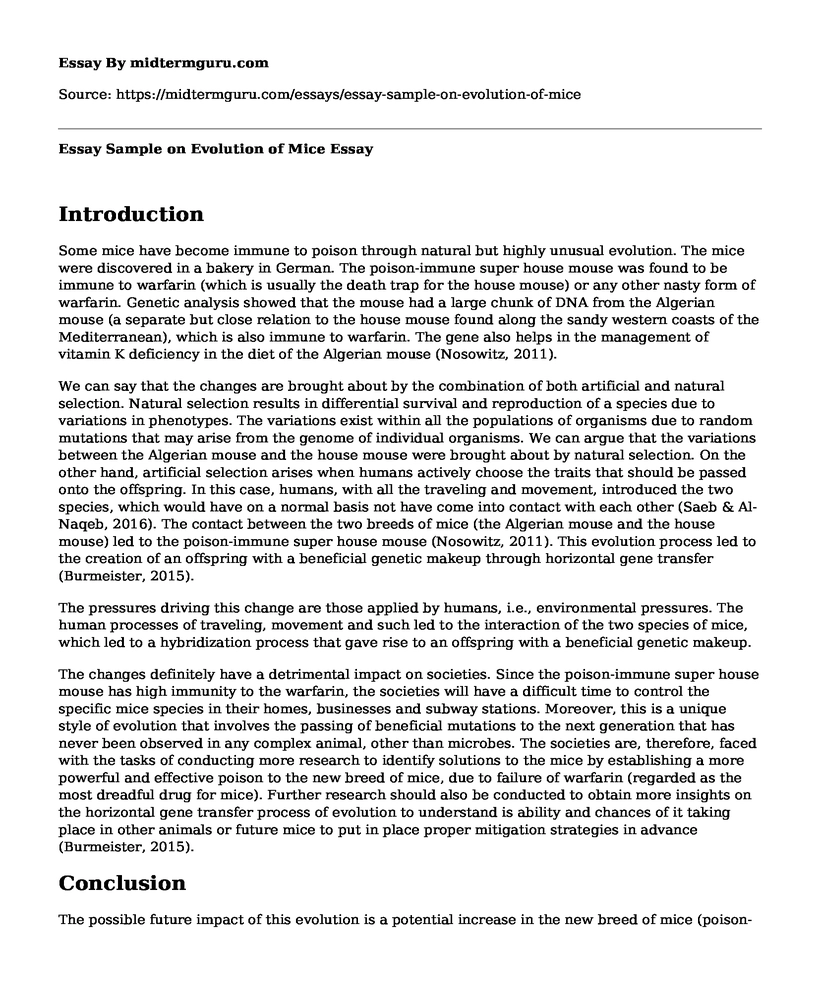Introduction
Some mice have become immune to poison through natural but highly unusual evolution. The mice were discovered in a bakery in German. The poison-immune super house mouse was found to be immune to warfarin (which is usually the death trap for the house mouse) or any other nasty form of warfarin. Genetic analysis showed that the mouse had a large chunk of DNA from the Algerian mouse (a separate but close relation to the house mouse found along the sandy western coasts of the Mediterranean), which is also immune to warfarin. The gene also helps in the management of vitamin K deficiency in the diet of the Algerian mouse (Nosowitz, 2011).
We can say that the changes are brought about by the combination of both artificial and natural selection. Natural selection results in differential survival and reproduction of a species due to variations in phenotypes. The variations exist within all the populations of organisms due to random mutations that may arise from the genome of individual organisms. We can argue that the variations between the Algerian mouse and the house mouse were brought about by natural selection. On the other hand, artificial selection arises when humans actively choose the traits that should be passed onto the offspring. In this case, humans, with all the traveling and movement, introduced the two species, which would have on a normal basis not have come into contact with each other (Saeb & Al-Naqeb, 2016). The contact between the two breeds of mice (the Algerian mouse and the house mouse) led to the poison-immune super house mouse (Nosowitz, 2011). This evolution process led to the creation of an offspring with a beneficial genetic makeup through horizontal gene transfer (Burmeister, 2015).
The pressures driving this change are those applied by humans, i.e., environmental pressures. The human processes of traveling, movement and such led to the interaction of the two species of mice, which led to a hybridization process that gave rise to an offspring with a beneficial genetic makeup.
The changes definitely have a detrimental impact on societies. Since the poison-immune super house mouse has high immunity to the warfarin, the societies will have a difficult time to control the specific mice species in their homes, businesses and subway stations. Moreover, this is a unique style of evolution that involves the passing of beneficial mutations to the next generation that has never been observed in any complex animal, other than microbes. The societies are, therefore, faced with the tasks of conducting more research to identify solutions to the mice by establishing a more powerful and effective poison to the new breed of mice, due to failure of warfarin (regarded as the most dreadful drug for mice). Further research should also be conducted to obtain more insights on the horizontal gene transfer process of evolution to understand is ability and chances of it taking place in other animals or future mice to put in place proper mitigation strategies in advance (Burmeister, 2015).
Conclusion
The possible future impact of this evolution is a potential increase in the new breed of mice (poison-immune super house mice) which would be cumbersome to eradicate. The mice will, therefore, probably be pleased, while people leaving in the affected areas will suffer their wrath. However, the negative future impacts include increased costs of research, design of new poisons and coping up with the increased mouse population in the affected regions.
References
Burmeister, A. (2015). Horizontal Gene Transfer: Figure 1. Evolution, Medicine, And Public Health, 2015(1), 193-194. doi:10.1093/emph/eov018
Nosowitz, D. (2011). Some mice have become immune to poison through natural but highly unusual evolution. PopSci.com. Retrieved from https://www.popsci.com/science/article/2011-07/some-mice-have-become-immune-poison-through-natural-highly-unusual-evolution
Saeb, A., & Al-Naqeb, D. (2016). The Impact of Evolutionary Driving Forces on Human Complex Diseases: A Population Genetics Approach. Scientifica, 2016, 1-10. doi:10.1155/2016/2079704
Cite this page
Essay Sample on Evolution of Mice. (2022, Sep 12). Retrieved from https://midtermguru.com/essays/essay-sample-on-evolution-of-mice
If you are the original author of this essay and no longer wish to have it published on the midtermguru.com website, please click below to request its removal:
- Overview of the EEG Signal Processing Technique
- Essay on Reproductive Techniques and Technologies: Cohen and Mcmahan
- Differences Between a Healthy and an Unhealthy Brain - Essay Example
- Paper Example on Microbiology
- Essay Sample on Parts of the Brain: Hippocampus, Frontal Lobe, Parietal Lobe and Amygdala
- Memory, Learning, Creativity and Intelligence Interrelation - Essay Sample
- CTE: Brain Injuries, Thinking & Memory Problems, and Behavioral Changes - Research Paper







